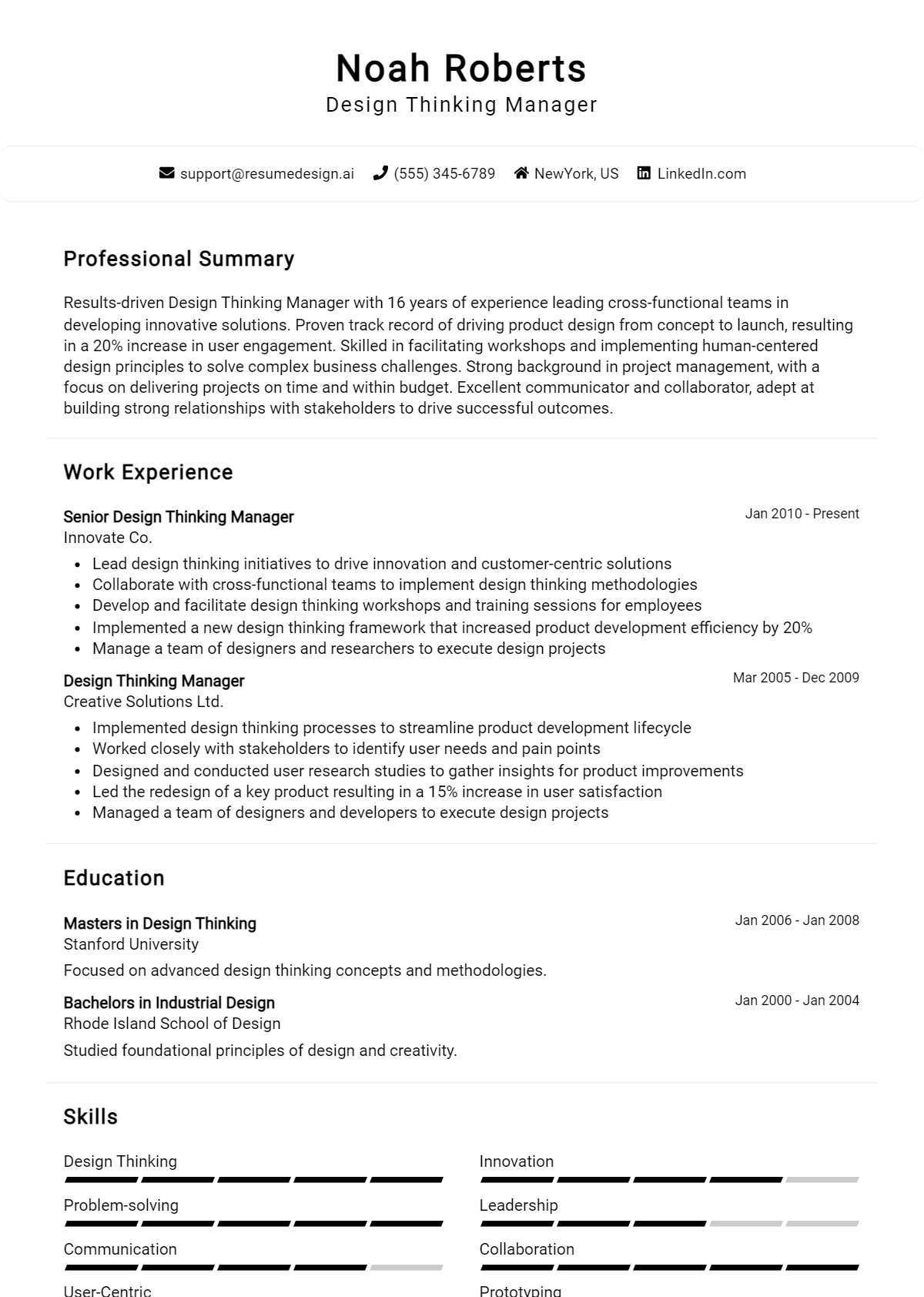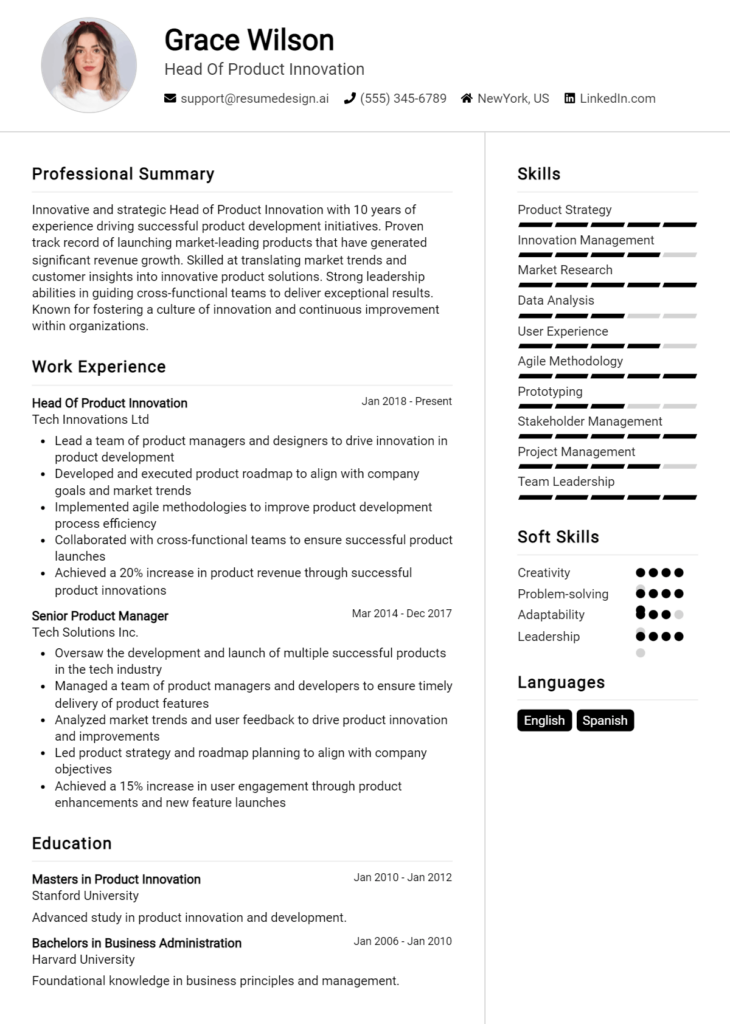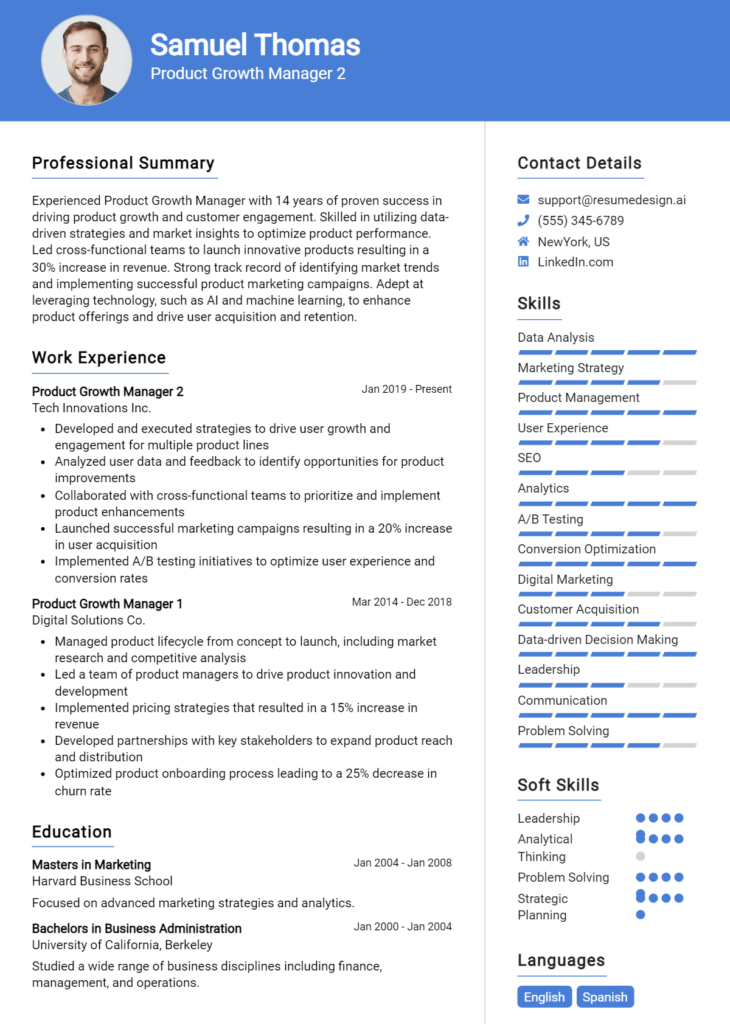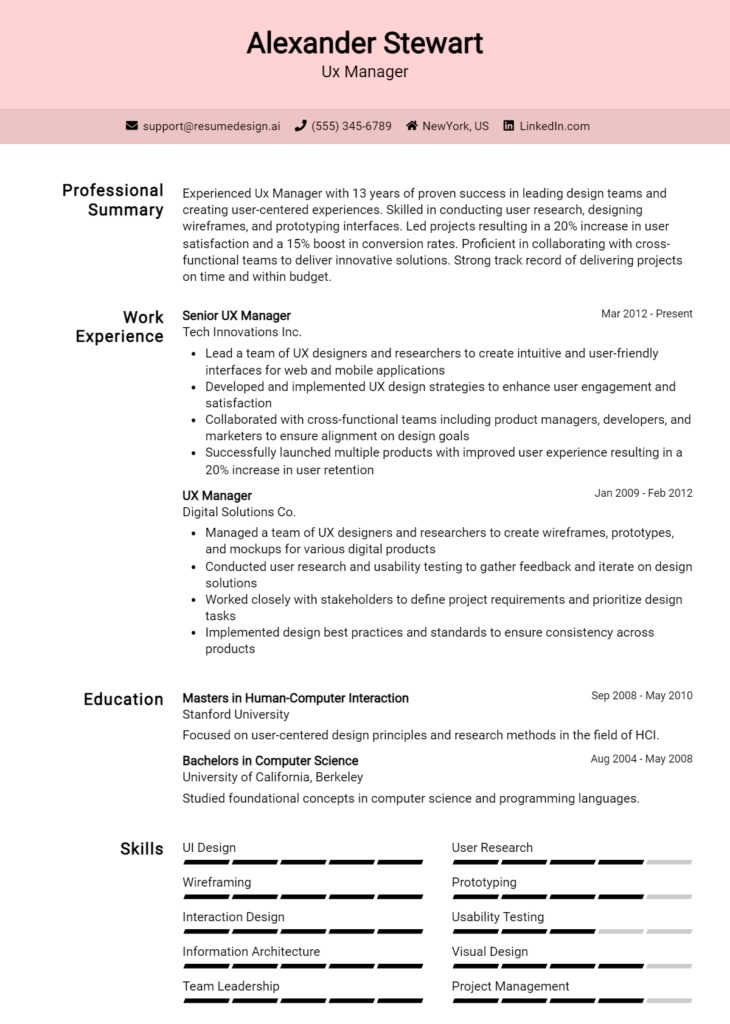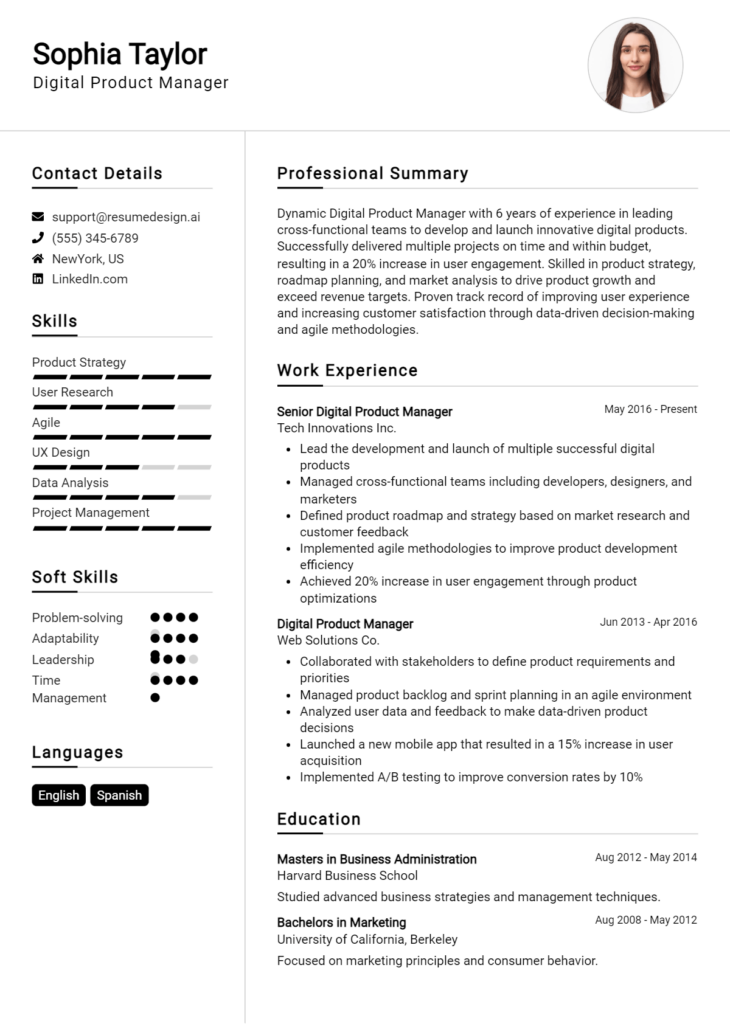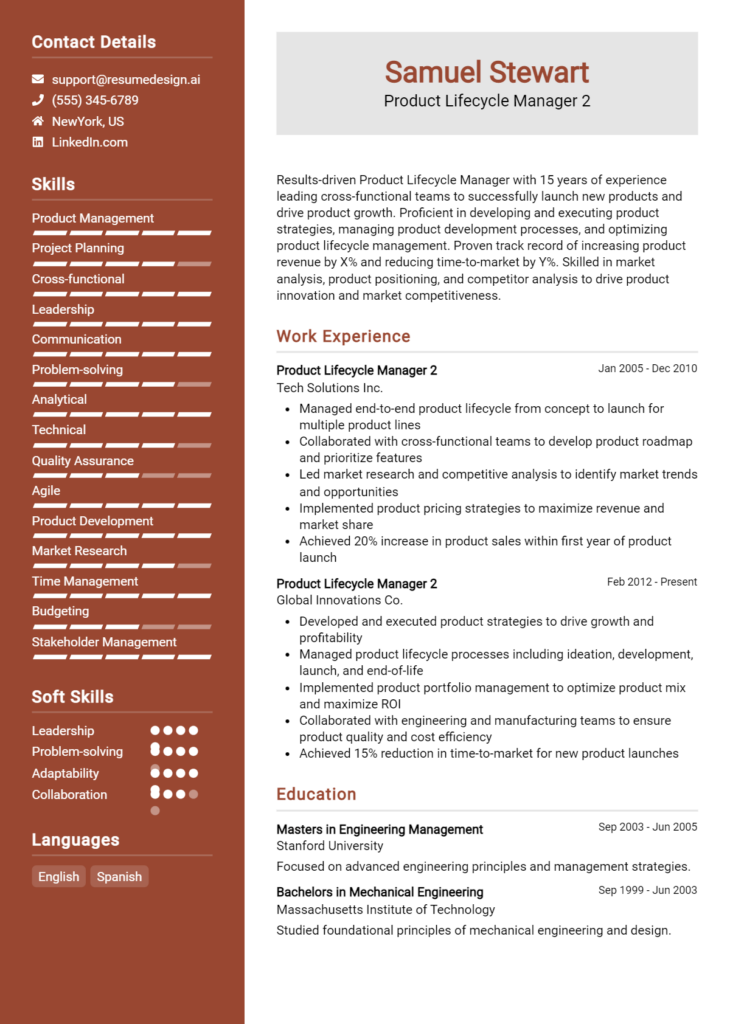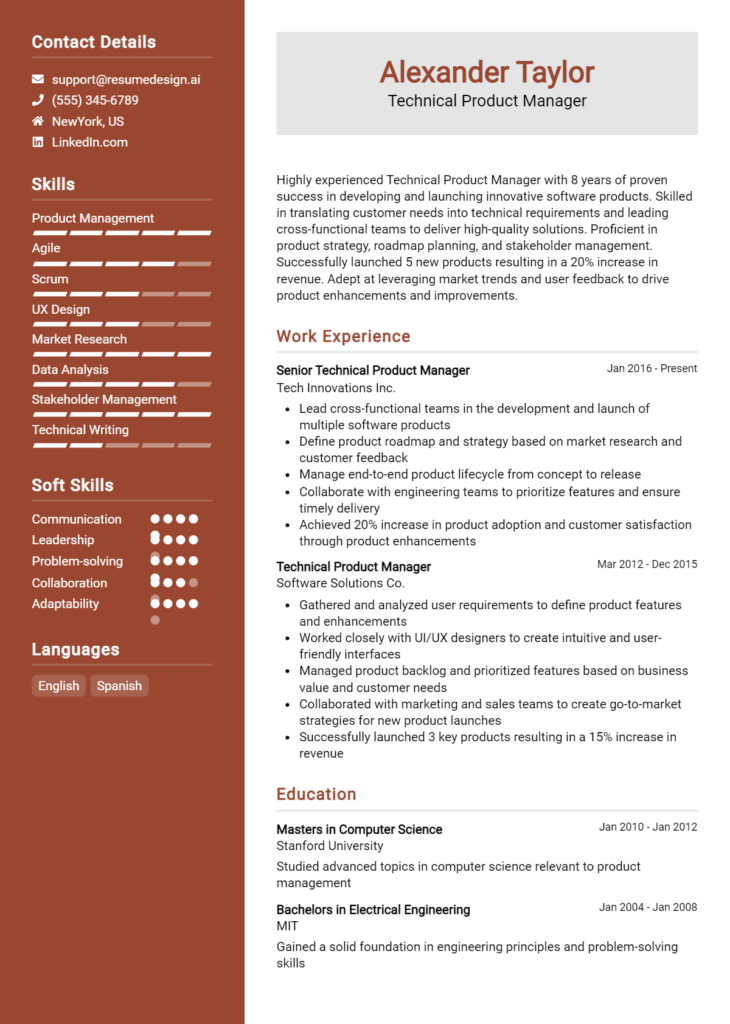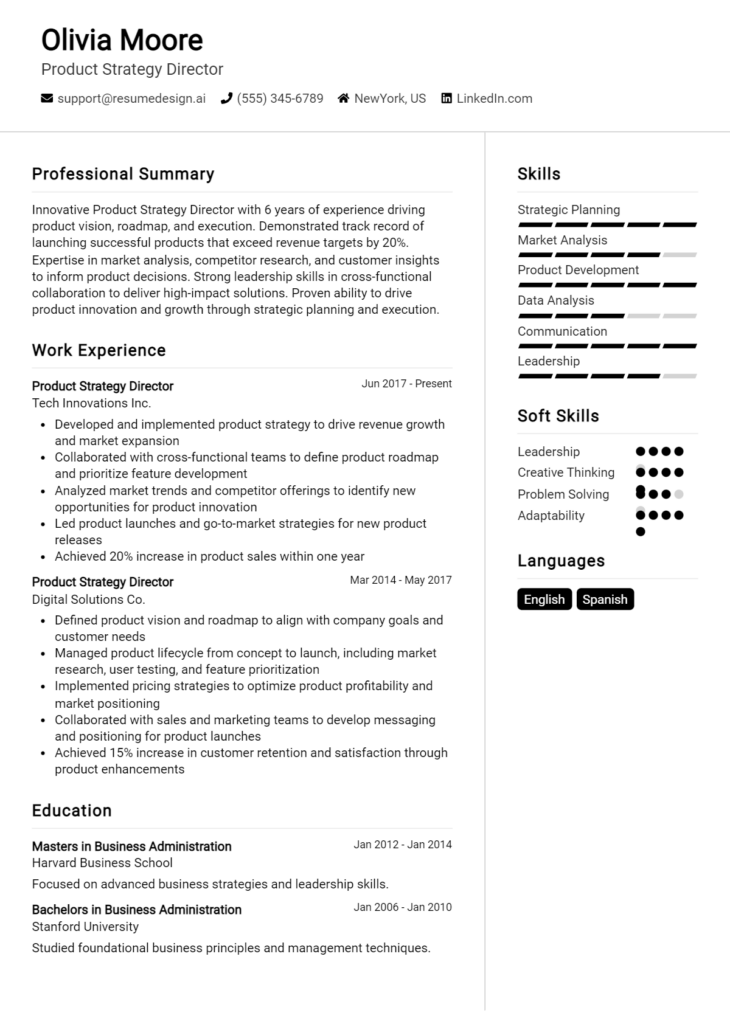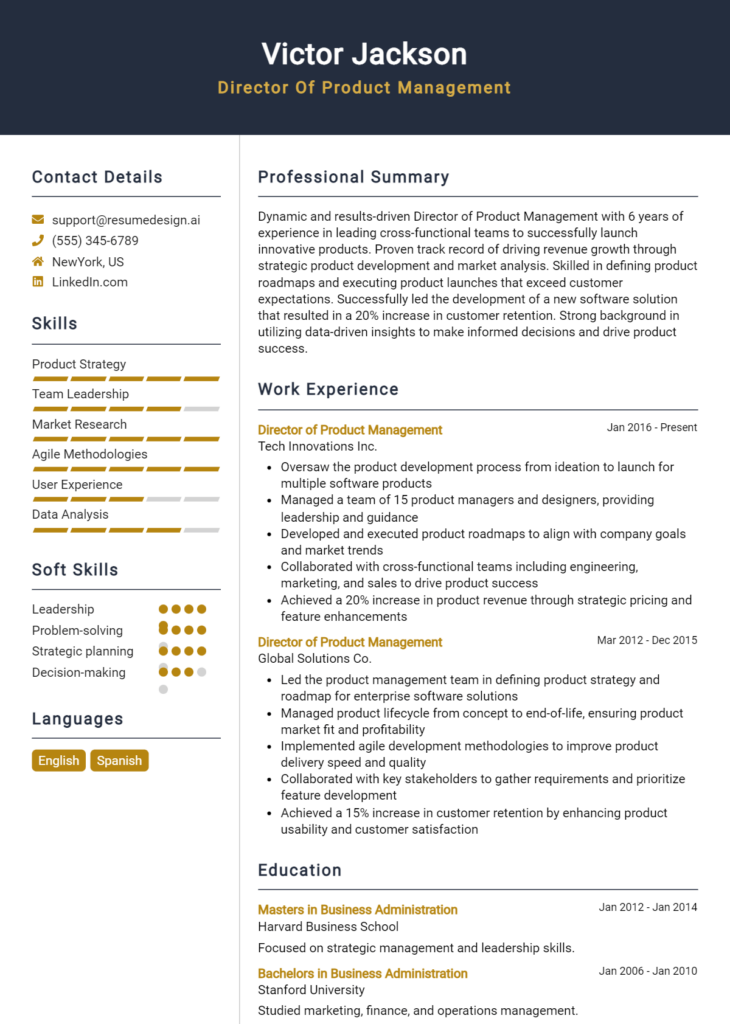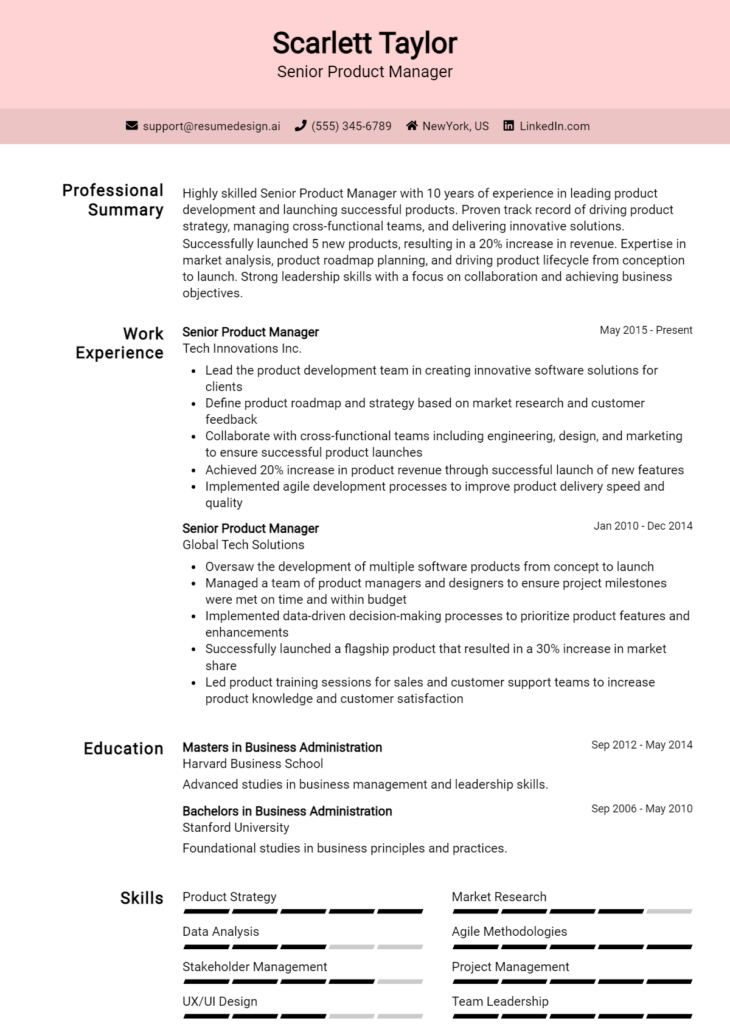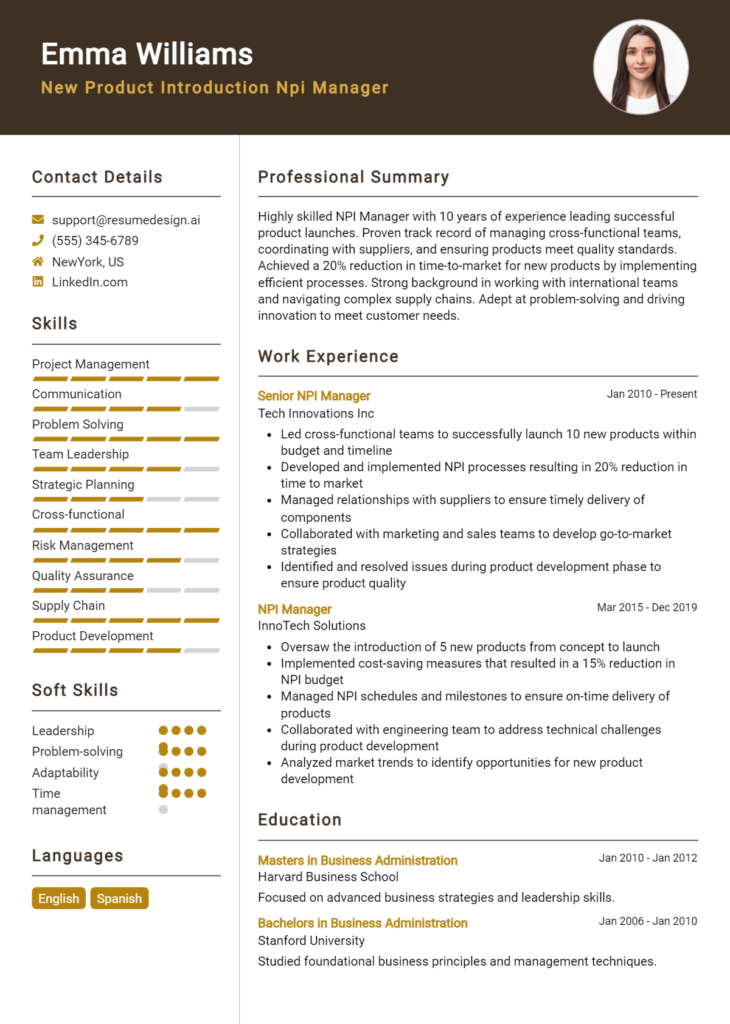Design Thinking Manager Core Responsibilities
A Design Thinking Manager plays a crucial role in fostering innovation by bridging various departments, such as design, engineering, and marketing. This professional is responsible for guiding teams through the design thinking process, emphasizing empathy, ideation, and prototyping. Essential skills include strong problem-solving capabilities, technical expertise, and operational insight. These skills help align cross-functional teams with the organization's goals, ensuring that user-centered solutions are effectively developed and implemented. A well-structured resume can highlight these qualifications, demonstrating the candidate's ability to drive impactful change.
Common Responsibilities Listed on Design Thinking Manager Resume
- Facilitating workshops and brainstorming sessions to encourage creative problem-solving.
- Leading cross-functional teams in developing user-centered design solutions.
- Conducting user research and usability testing to gather insights and feedback.
- Creating design prototypes and mockups to visualize concepts.
- Collaborating with product managers and stakeholders to define project requirements.
- Developing and implementing design thinking methodologies and best practices.
- Analyzing market trends and user needs to inform design strategies.
- Training and mentoring team members in design thinking principles.
- Measuring and evaluating the impact of design initiatives on business outcomes.
- Communicating design ideas and solutions effectively to diverse audiences.
- Advocating for user-centered design within the organization.
High-Level Resume Tips for Design Thinking Manager Professionals
In the competitive landscape of design thinking, a well-crafted resume is essential for professionals vying for the role of Design Thinking Manager. Your resume is often the first impression you make on potential employers, serving as a critical document that reflects not only your skills and accomplishments but also your ability to think creatively and strategically. In a field where innovation and user-centric design are paramount, it's essential that your resume articulates your unique value proposition. This guide will provide practical and actionable resume tips specifically tailored for Design Thinking Manager professionals, helping you stand out in a crowded job market.
Top Resume Tips for Design Thinking Manager Professionals
- Tailor your resume to the job description by using relevant keywords and phrases that reflect the requirements of the position.
- Showcase your relevant experience by emphasizing projects that demonstrate your expertise in design thinking methodologies.
- Quantify your achievements with specific metrics, such as improved user satisfaction scores or increased project efficiency.
- Highlight industry-specific skills, such as user research, prototyping, and iterative design processes.
- Include a section on certifications or relevant training programs that enhance your qualifications in design thinking.
- Incorporate a portfolio link to showcase your work visually, demonstrating your design capabilities and thought processes.
- Utilize strong action verbs to describe your contributions, such as "led," "developed," "facilitated," and "innovated."
- Keep your resume concise and focused, ideally one to two pages, to ensure it is easily digestible for hiring managers.
- Use a clean and professional layout that reflects your design sensibility and attention to detail.
- Include testimonials or endorsements from colleagues or clients that speak to your design thinking expertise and collaborative approach.
By implementing these tips, you significantly enhance your chances of landing a job in the Design Thinking Manager field. A polished and strategically tailored resume not only showcases your skills and accomplishments but also demonstrates your understanding of the design thinking process and your ability to lead innovative projects. Stand out from the competition and make your first impression count!
Why Resume Headlines & Titles are Important for Design Thinking Manager
Resume headlines and titles play a crucial role in a Design Thinking Manager's resume by serving as the first impression for hiring managers. A well-crafted headline can instantly capture attention, summarizing a candidate's key qualifications in a compelling and concise manner. This brief yet significant phrase should encapsulate the essence of the candidate's expertise, making it relevant to the specific role being applied for. A strong title not only sets the tone for the rest of the resume but also helps candidates stand out in a competitive job market.
Best Practices for Crafting Resume Headlines for Design Thinking Manager
- Keep it concise: Aim for a headline that is no longer than 10-12 words.
- Be specific: Tailor the headline to reflect the exact role and responsibilities of a Design Thinking Manager.
- Highlight key skills: Include essential skills that are relevant to design thinking, such as user research, prototyping, and team leadership.
- Showcase accomplishments: If possible, incorporate measurable achievements or notable projects.
- Use industry keywords: Utilize terms commonly found in job descriptions for design thinking roles to enhance visibility.
- Avoid jargon: Ensure that the language is clear and easily understandable, avoiding overly technical terms.
- Focus on impact: Emphasize how your expertise contributes to enhancing user experiences and driving innovation.
- Match the job description: Align your headline with the specific requirements and expectations outlined in the job listing.
Example Resume Headlines for Design Thinking Manager
Strong Resume Headlines
Innovative Design Thinking Manager with 10+ Years of Experience in User-Centered Solutions
Strategic Design Thinking Leader Specializing in Cross-Functional Team Collaboration
Results-Driven Design Thinking Manager with Proven Track Record in Enhancing User Engagement
Weak Resume Headlines
Manager Seeking New Opportunities
Experienced Professional in Design
The strong headlines are effective because they immediately communicate the candidate's specific expertise and experiences in design thinking, making them relevant and impactful. They highlight the candidate's strengths and the value they bring to potential employers. In contrast, the weak headlines fail to impress due to their vagueness and lack of focus; they do not convey any unique qualifications or insights into the candidate's abilities, making them easily forgettable in a competitive job market.
Writing an Exceptional Design Thinking Manager Resume Summary
A well-crafted resume summary is crucial for a Design Thinking Manager as it serves as the first impression to hiring managers. This brief yet powerful section encapsulates key skills, pertinent experience, and significant accomplishments that align directly with the job role. A strong summary not only captures attention quickly but also sets the tone for the rest of the resume, making it essential for candidates to be concise, impactful, and tailored to the specific position they are applying for. By highlighting what makes them unique, candidates can effectively differentiate themselves in a competitive job market.
Best Practices for Writing a Design Thinking Manager Resume Summary
- Quantify Achievements: Use numbers and metrics to demonstrate the impact of your work.
- Focus on Relevant Skills: Highlight skills specifically mentioned in the job description.
- Tailor for the Job: Customize your summary for each application to align with the company’s goals.
- Use Action-Oriented Language: Start with strong verbs that convey your achievements and capabilities.
- Showcase Leadership Experience: Emphasize your ability to lead teams and drive design thinking initiatives.
- Keep it Concise: Aim for 3-5 sentences that convey the most critical information succinctly.
- Highlight Problem-Solving Skills: Illustrate how your design thinking approach has solved real-world problems.
- Include Industry Knowledge: Mention familiarity with industry best practices or trends related to design thinking.
Example Design Thinking Manager Resume Summaries
Strong Resume Summaries
Dynamic Design Thinking Manager with over 8 years of experience leading cross-functional teams to innovate customer-centric solutions, resulting in a 30% increase in user engagement for key products.
Results-oriented Design Thinking professional with a proven track record of reducing project delivery times by 25% through effective facilitation of ideation workshops and iterative prototyping processes.
Creative Design Thinking Manager skilled in integrating user research and data analytics, successfully launching 5 new products that generated over $1M in revenue within the first year of release.
Strategic thinker with expertise in applying design thinking methodologies across diverse sectors; led a team to enhance service design, achieving a 40% improvement in customer satisfaction scores.
Weak Resume Summaries
Experienced manager with a background in design thinking and a focus on improving processes.
I have worked in various roles related to design thinking and have led teams in different projects.
The strong resume summaries are effective because they provide specific, quantifiable achievements and relevant skills tailored to the Design Thinking Manager role. They showcase a clear impact on business outcomes and demonstrate an understanding of the design thinking process. In contrast, the weak summaries lack detail and specificity, making them less impactful and failing to convey the candidate's value or relevance to the job opportunity.
Work Experience Section for Design Thinking Manager Resume
The work experience section of a Design Thinking Manager resume is a critical component that allows candidates to effectively demonstrate their technical skills, leadership capabilities, and success in delivering high-quality products. This section not only highlights relevant past roles but also showcases the candidate's ability to manage teams through the design thinking process, ensuring user-centered solutions. By quantifying achievements and aligning previous experiences with industry standards, candidates can present a compelling case for their expertise and fit for the role, making it essential to articulate accomplishments clearly and effectively.
Best Practices for Design Thinking Manager Work Experience
- Focus on specific design thinking methodologies utilized and their impact on projects.
- Quantify achievements using metrics, such as percentage improvements, cost savings, or revenue growth.
- Highlight collaborative efforts with cross-functional teams to demonstrate teamwork and communication skills.
- Describe leadership roles in managing design projects, emphasizing the ability to mentor and guide teams.
- Include relevant tools and technologies used in the design thinking process, showcasing technical expertise.
- Tailor your experience to align with industry standards and expectations for design thinking roles.
- Use action verbs to convey a sense of proactivity and ownership in your responsibilities.
- Incorporate user feedback and research outcomes to illustrate the impact of your work on end-users.
Example Work Experiences for Design Thinking Manager
Strong Experiences
- Led a cross-disciplinary team of 10 to redesign an e-commerce platform, resulting in a 30% increase in conversion rates and a 25% reduction in customer complaints.
- Implemented a user-centered design process that improved product usability scores by 40%, enhancing user satisfaction and retention.
- Facilitated over 15 design thinking workshops, fostering collaboration among stakeholders and generating over 50 actionable insights that drove product innovation.
- Managed the development of a mobile application that achieved 100,000 downloads within the first six months, exceeding projected targets by 50%.
Weak Experiences
- Worked on various design projects without specifying outcomes or contributions.
- Participated in team meetings and discussions regarding product improvements.
- Helped with design-related tasks as needed.
- Assisted in user research without detailing the techniques used or results achieved.
The examples provided illustrate the distinction between strong and weak experiences in a Design Thinking Manager's resume. Strong experiences are characterized by specific, quantifiable outcomes and leadership roles that highlight the candidate's impact on projects and teams. In contrast, weak experiences lack detail and fail to demonstrate the candidate's contributions or the results of their work, making them less compelling to potential employers.
Education and Certifications Section for Design Thinking Manager Resume
The education and certifications section of a Design Thinking Manager resume is crucial as it serves to showcase the candidate's academic background and professional qualifications. This section highlights the candidate’s commitment to continuous learning and the acquisition of industry-relevant skills necessary for effective design thinking practices. By detailing relevant coursework, certifications, and specialized training, candidates can significantly enhance their credibility and demonstrate their alignment with the requirements of the job role, ultimately making a stronger case for their candidacy.
Best Practices for Design Thinking Manager Education and Certifications
- Include degrees relevant to design, innovation, or management to showcase foundational knowledge.
- List industry-recognized certifications (e.g., Certified Design Thinking Practitioner) to enhance credibility.
- Highlight relevant coursework that demonstrates specialized skills in areas such as user experience, product design, or research methodologies.
- Provide details about any workshops or seminars attended that are pertinent to design thinking and innovation.
- Use clear titles and dates to present your qualifications in a well-organized manner.
- Emphasize certifications that reflect ongoing professional development and adaptability in the field.
- Prioritize the most relevant qualifications at the top of the section for immediate visibility.
- Tailor the content to match the job description, ensuring that all listed qualifications align with the employer's requirements.
Example Education and Certifications for Design Thinking Manager
Strong Examples
- M.S. in Human-Centered Design from Stanford University
- Certified Design Thinking Professional from IDEO U
- Completed coursework in User Experience Research and Prototyping
- Certification in Agile Project Management from the Project Management Institute
Weak Examples
- B.A. in History
- Certification in Basic Computer Skills
- Completed a workshop on Creative Writing
- High School Diploma
The strong examples are considered effective because they directly relate to the competencies required for a Design Thinking Manager, showcasing relevant education and certifications that validate the candidate's expertise in design thinking methodologies and practices. In contrast, the weak examples fail to provide relevant qualifications and do not align with the expectations for the role, which could undermine the candidate's credibility and suitability for the position.
Top Skills & Keywords for Design Thinking Manager Resume
A well-crafted resume for a Design Thinking Manager should highlight a blend of essential skills that demonstrate both creativity and strategic thinking. As the role focuses on fostering innovation, collaboration, and user-centric solutions, showcasing your skills effectively can make a significant difference in attracting potential employers. Skills are not just buzzwords; they reflect your ability to lead teams, empathize with users, and drive impactful design processes. Including relevant skills in your resume will not only enhance your candidacy but also provide a clear picture of your qualifications and how you can contribute to an organization's success.
Top Hard & Soft Skills for Design Thinking Manager
Soft Skills
- Empathy
- Creative Problem-Solving
- Collaboration
- Communication
- Adaptability
- Critical Thinking
- Leadership
- Facilitation
- Time Management
- Stakeholder Engagement
- Conflict Resolution
- Open-Mindedness
- User Advocacy
- Team Building
- Cultural Awareness
Hard Skills
- Design Research Techniques
- Prototyping and Wireframing
- User Experience (UX) Design
- Agile Methodologies
- Data Analysis and Interpretation
- Journey Mapping
- Usability Testing
- Visual Design Principles
- Product Development Lifecycle
- Customer Journey Analysis
- Strategic Planning
- Innovation Management
- Software Tools (e.g., Sketch, Figma, Adobe Creative Suite)
- HTML/CSS Basics
- Project Management Tools (e.g., Trello, JIRA)
By emphasizing these skills in your resume, you can effectively convey your qualifications and readiness to excel in the role of a Design Thinking Manager. Additionally, don’t forget to highlight relevant work experience that demonstrates how you’ve successfully applied these skills in real-world scenarios.
Stand Out with a Winning Design Thinking Manager Cover Letter
I am excited to apply for the Design Thinking Manager position at [Company Name], as advertised on [Job Board/Company Website]. With a robust background in design thinking methodologies and a passion for fostering innovative solutions, I am eager to contribute to your team by enhancing user experiences and driving strategic design initiatives. My experience in leading cross-functional teams to develop user-centered designs has equipped me with the skills necessary to excel in this role and make a significant impact on [Company Name]'s objectives.
In my previous role at [Previous Company Name], I successfully spearheaded multiple design thinking workshops that resulted in a 30% increase in stakeholder engagement and a 20% improvement in project turnaround time. By employing empathy-driven research and iterative prototyping, I was able to guide teams through complex problem-solving processes that led to successful product launches. My ability to translate user insights into actionable strategies has not only optimized design outcomes but has also enhanced collaboration among diverse teams, ensuring that every voice is heard and valued.
I am particularly drawn to the opportunity at [Company Name] because of your commitment to innovation and user-centric design. I am impressed by [specific project or initiative from the company], and I believe that my expertise in facilitating design thinking methodologies can contribute to further advancing these efforts. I am eager to bring my strategic vision and hands-on experience to your team, fostering a culture of creativity and continuous improvement.
Thank you for considering my application. I look forward to the possibility of discussing how my experience and skills align with the goals of [Company Name]. I am enthusiastic about the potential to collaborate with your talented team to drive impactful design solutions that resonate with users and elevate the brand.
Common Mistakes to Avoid in a Design Thinking Manager Resume
When crafting a resume for a Design Thinking Manager position, it's essential to present a strong and relevant profile that highlights your skills, experiences, and understanding of design thinking principles. However, many candidates make common mistakes that can undermine their application. Avoiding these pitfalls can significantly enhance your chances of making a positive impression on potential employers.
Vague Job Descriptions: Using generic terms instead of specific achievements can make your resume less impactful. Clearly outline your roles and the outcomes of your projects.
Neglecting Soft Skills: Design thinking relies heavily on collaboration and empathy. Failing to highlight your interpersonal skills can leave a gap in your qualifications.
Ignoring the User-Centric Approach: Not emphasizing your experience in user research and feedback can make it difficult for employers to see your commitment to a user-centered design philosophy.
Overloading with Technical Jargon: While it's important to demonstrate your knowledge, using too much industry jargon can alienate those outside of your technical background. Focus on clarity and relatability.
Lack of Quantifiable Results: Employers appreciate measurable impacts. Failing to include metrics, such as project completion rates or user satisfaction scores, can weaken your narrative.
Inconsistent Formatting: A cluttered or inconsistent layout can detract from your professionalism. Ensure your resume is clean, organized, and easy to read.
Missing Relevant Keywords: Many companies use Applicant Tracking Systems (ATS) to screen resumes. Not incorporating relevant keywords from the job description can result in your resume being overlooked.
Not Tailoring for Each Application: Sending the same resume for different positions can be detrimental. Tailor your resume to highlight experiences and skills that align specifically with each job description.
Conclusion
As a Design Thinking Manager, your role is pivotal in fostering innovation and driving user-centered solutions within your organization. Throughout this article, we explored the essential skills and experiences that define a successful Design Thinking Manager, including empathy, collaboration, and a strong understanding of design methodologies. We also discussed the importance of effective communication and the ability to lead cross-functional teams in order to create impactful design strategies that align with business goals.
Now is the perfect time to reflect on your qualifications and ensure that your resume effectively showcases your unique strengths and experiences in design thinking. Take a moment to review your Design Thinking Manager resume and make any necessary updates to highlight your achievements and skills.
To assist you in this process, consider utilizing various tools that can enhance your resume. Check out our resume templates for professionally designed formats that can help you stand out. If you prefer a more hands-on approach, our resume builder offers an easy way to create a customized resume tailored to your career aspirations. Additionally, you can explore resume examples to gain inspiration from successful Design Thinking Managers. Don't forget to complement your resume with a compelling introduction by using our cover letter templates.
By taking these steps, you can enhance your chances of landing the desired role and showcasing your expertise in design thinking. Start reviewing and refining your resume today!

